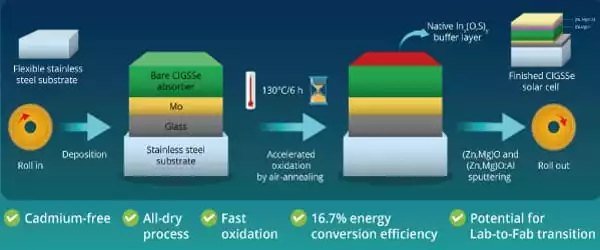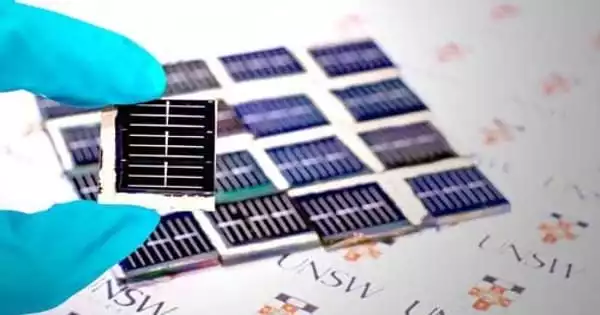A thin-film solar cell (TFSC) is a second-generation solar cell manufactured by depositing one or more thin layers, or thin films (TF), of photovoltaic material over a substrate such as glass, plastic, or metal. Thin-film solar cells, such as cadmium telluride (CdTe), copper indium gallium diselenide (CIGS), and amorphous thin-film silicon, are commercially employed in a variety of technologies (a-Si, TF-Si).
While solar cells offer a terrific alternative to fossil fuels, the environmental impact of the manufacturing processes has been a source of concern. Toxic elements such as cadmium and industrial waste are frequently used in the production of solar panels. In a new study, researchers have now developed an eco-friendly method that eliminates the use of toxic cadmium in the production process to produce cost-effective, efficient, and eco-friendly solar cells.
Climate change, one of the most pressing global issues today, has demonstrated that fossil fuels are harmful to our environment and are not sustainable. Adoption of renewable energy sources is critical, and solar cells are a popular contender in this regard. While efficiency is the key priority for solar cells, researchers have also concentrated on building lightweight, low-cost, and flexible solar cells. However, the manufacturing method has caused major environmental concerns due to the usage of harmful ingredients and the accumulation of industrial waste.
We have demonstrated for the first time that oxidizing the CIGSSe surface using efficient air-annealing technique results in a significant increase in energy conversion efficiency. The approach proposed in our work can be extended to large-scale manufacturing applications, which is what we need to make solar cells a clean energy resource not only in Japan but around the world.
Prof. Minemoto
Copper indium gallium selenide (CIGSe), for example, is a thin-film solar cell that has various benefits over standard silicon solar cells. Thin-film solar cells are approximately 100 times thinner, less expensive to manufacture, and easier to mount on rooftops and cars. Furthermore, CIGSe absorbs light more powerfully and can be produced into thinner films than other photovoltaic materials used in thin-film solar cells such as amorphous silicon, cadmium telluride, and organic compounds. They do, however, include a cadmium sulfide buffer layer, which is highly poisonous and carcinogenic. Finding alternate, non-toxic materials is therefore critical for large-scale production and installation of CIGSe panels.
Film thickness varies from a few nanometers (nm) to tens of micrometers (µm), far thinner than thin-competing film’s technology, the conventional, first-generation crystalline silicon solar cell (c-Si), that utilizes wafers of up to 200 µm thick. This permits thin-film cells to be flexible, and lighter in weight. It is utilized in building-integrated photovoltaics and as semi-transparent, photovoltaic glazing material that may be bonded onto windows. In some of the world’s largest photovoltaic power facilities, stiff thin-film solar panels (interleaved between two panes of glass) are used in commercial applications.

For Professors Jakapan Chantana and Takashi Minemoto at Ritsumeikan University, Japan, removing cadmium from solar cells was as important as developing an eco-friendly manufacturing process that is both efficient and affordable. Addressing these issues in a new study, a research team led by them developed a strategy in which the traditional cadmium sulfide buffer layer was replaced with a native buffer layer formed by oxidizing the surface of the Cu(In,Ga)(S,Se)2 CIGSSe layer with an air-annealing process. The study was published on March 26, 2022, in the journal Solar RRL.
While previous attempts to oxidize the CIGSSe layer were performed, the surface typically takes months to oxidize. However, using the new technology, the team was able to cut the oxidation time to a few hours, allowing for speedier manufacture via a “roll-to-roll” process. A CIGSSe layer is first deposited on a flexible stainless-steel substrate in this technique. Following deposition, an air-annealing process oxidizes the surface of the CIGSSe layer to generate native buffer layers of Inx(O,S)y. The researchers created a CIGSSe solar cell with a maximum energy conversion efficiency of 16.7 percent after 6 hours of oxidation at 130°C by testing with different oxidation settings.
“We have demonstrated for the first time that oxidizing the CIGSSe surface using efficient air-annealing technique results in a significant increase in energy conversion efficiency,” Prof. Minemoto explains.
Although the reported efficiency is lower than that of traditional solar cells (which normally exceeds 20%), the new process eliminates cadmium, making the solar cells environmentally friendly. “Cadmium is deposited on the CIGSSe layer using a chemical bath deposition technique in the traditional process. By eliminating this step, we have created a completely dry manufacturing process that produces less waste “Prof. Chantana elaborates. Furthermore, the method is inexpensive.
Solar panels must grow more efficient, cost-effective, and environmentally benign in order to become a viable source of renewable energy. “The approach proposed in our work can be extended to large-scale manufacturing applications,” Prof. Minemoto concludes, “which is what we need to make solar cells a clean energy resource not only in Japan but around the world.”





